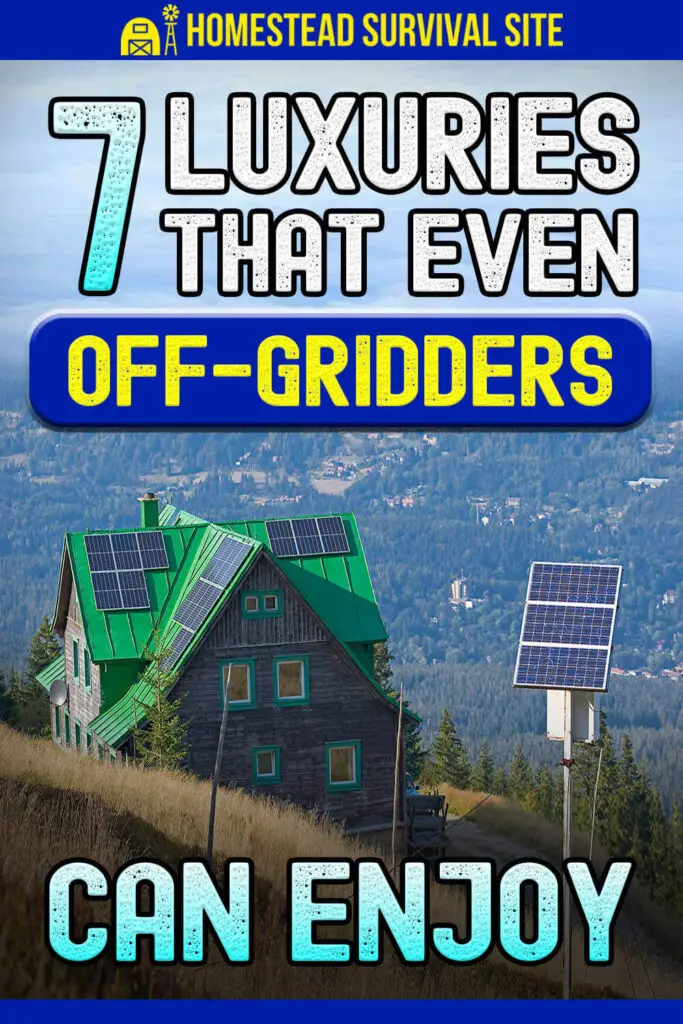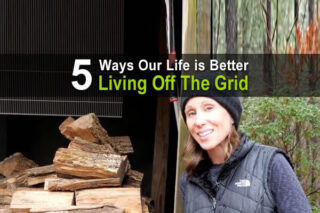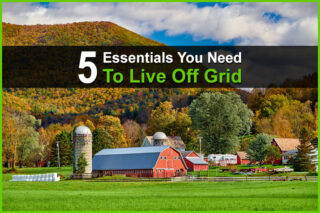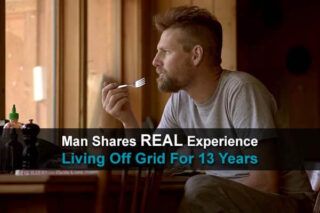Estimated reading time: 6 minutes
Most people think of off-grid living as “roughing it.” They assume you’ll be hauling water, hand splitting wood, and enduring long days of backbreaking labor. While that can be your off-grid experience, it doesn’t have to be. You can choose to give up your suburban luxuries when you move off the grid, but it’s a choice, not a necessity.
When we moved to an off-grid cabin in rural Vermont 5 years ago, I assumed it’d be the hardest thing I’d ever done. In many ways, it has been challenging, but for the most part, we’ve been able to enjoy more luxuries than we ever had while living in town.
Our small solar array produces more electricity than we can reasonably use 8 to 9 months of the year, meaning that we’ve actually converted some appliances to electric and invested in more seasonal electric luxuries to take advantage of the free glut of electricity.
Want to save this post for later? Click Here to Pin It On Pinterest!
With a setup like this, you can live off the grid in comfort and style. Here are seven examples:
1. Whirlpool Bath Tub
Very few suburban homes have the luxury of a whirlpool bathtub. Running the jets takes roughly as much electricity as running an electric oven and toaster at the same time, and that’s after you’ve run a well pump for 20 minutes to fill the thing. Even on the grid, running a bath tub like that would be expensive. Off grid, once the batteries are full, if you can't use the electricity generated by your panels it has nowhere to go and it’s just wasted. It takes a pretty big mental shift to realize that you’re actually being wasteful by NOT lounging in a tub with jets massaging out the morning’s labor.
2. Solar Powered Hot Water
Realizing that most of the year we were producing far more electricity than we could use, an electric water heater actually makes a lot of sense off the grid. The electric water heater works as a pre-heat tank before the water goes into our year round propane water heater. Once the batteries are full, a charge controller shifts production from the batteries directly into making hot water.
Believe it or not, with a few sunny days in a row, the water was at 160 degrees in the preheat tank, hot enough to cause serious burns if you’re not careful. All from electricity that would just have been wasted otherwise. We found ourselves actually having to take “mandatory” whirlpool baths at the end of the day just to bring the temperature down. Off grid life sounds pretty rugged, right?
3. Dishwasher
Getting all your electric powered housework done while the sun is shining can be a bit of a challenge if you want to spend sunny days outdoors. A dishwasher allows you to get the dishes done during peak solar production without actually slaving over a hot sink in the heat of the day. If you’ve rigged up an electric water heater, all that free hot water will go to work cleaning your dishes while you’re spending the day out in the woods.
4. Air Conditioner
One of the main arguments against solar on a grand scale is that it’s not dependable enough to handle peak load on the grid when everyone in town is running their air conditioner. This argument never made sense to me, because even off the grid when it’s hot most the time, the sun is shining and peak load matches peak production. While on a small scale system, you probably can't run a whole house system, but a small window air conditioner unit to keep a room cool barely dents production during the heat of the day.
5. Dehumidifier
On hot humid days, we crank on a large whole house dehumidifier in the basement to dry things out a bit and make our lives a lot more comfortable. Can you run these things all night? Nope. But you can cool your house for free while the sun is shining, and taking the edge off during the day means you sleep comfortable and cool all night long.
6. Radiant Floor Heat
Before moving off the grid, my feet were always cold in the winter. Slippers and all the rugs in the world couldn’t keep the cold from getting at you through the floors up here in the north country. Radiant floor heat is one of the most efficient ways to heat your house, but even if you’re powering it with wood, a system requires a good bit of electricity to pump heated fluid (water or antifreeze) through tubing running beneath your floors.
When your solar electricity budget is tight in the winter, extra electricity to pump heat through piping in your floors can be a problem. With increased use of solar and more and more people moving off the grid, the technology is advancing, and super efficient DC electric pumps are now available. That means you can pump all the heat you want through your floors with just the electricity it requires to run a few light bulbs. Off grid, I find myself going barefoot in the house and we’ve given away the rugs. I was never this warm and comfortable in the winter until moving off grid.
7. Wood Powered Hot Water
In the winter, we’re not often able to take advantage of free, solar-powered hot water. Occasionally, yes, but for the most part, that’s a summer luxury. Wood powered hot water, on the other hand, is more or less free if you’re running a boiler in the winter.
Adding a loop from our radiant floor heat into our electric pre-heat water heater means that anytime the heat is running through the floors, a small bit of that warmth is diverted to heat water. More often than not, we find ourselves having to turn off that loop because there’s too much hot water. Sometimes, even in the winter, we have “mandatory” bath time to draw down the oversupply of hot water. While we generally can't run the jets in January, if it’s below 40 degrees outside and you’re lounging in a hot tub, you don’t really consider the lack of jets as “roughing it.”
As you can see, with a combination of solar and wood power, and you enjoy all sorts of luxuries while living off the grid.
Like this post? Don't Forget to Pin It On Pinterest!













If you have not installed an “Inverter” yes, you are wasting electric from the solar panels. With the inverter, you back feed into the electric grid and in turn, the power company pays you. Even having a “Automatic Transfer Switch” helps when the power grid fails, it will automatically transfer to the solar power batteries. These two items pay for themselves and with the proper “Deep Cycle” batteries will last a long time.
Super information I’d not thought of before. Air conditioning! Hmmmmm.
I’m thinking of trying something for next winter to heat water. I have a rather large solar array. But after much research I’m going to get a wind turbine not a huge one but during winter the sun is a stranger. I will keep my solar but also feed my bank with wind and the divert load will be going to 12v heating elements in my pre water heater tank. The elements are cheap and the turbine system I’ve found on eBay isn’t near as expensive as I thought it would be. Do anyone have any experience with this setup that may have some pointers or something I’m missing? I had a this setup on a really small scale to thaw the animals water last winter but I made it using a small vehicle alternator and I’ll be the first to admit I made several mistakes because I didn’t know much about it when I made that one but after reading many books, blogs, and watching of course YouTube vids I’ve got a better grasp on it but no where near an expert. Any tips, tricks or ideas would be appreciated
I invented a device to make water out of air!!!!!!!! NO, i didn’t invent it but a dehumidifier will work for drinking water. Above ground most anyday will work to some degree probably even in Arizona/Nevada. Better in the Midwest. Now if you have an underground bunker made with Concrete block or poured concrete it will draw moisture from the ground. It should give enough water for drinking. I would run the water through an Aqua Cera or Berkey water filter to keep out any nasty algae, fungus, or germs.
You Miss something even closer to the core, a guitar, piano, violin or some horns being played with friends makes all the difference in the world. They require no electricity just a lot of enthusiasm